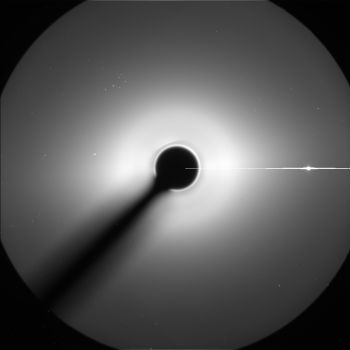Me, earlier this week walking to the supermarket: "Boy, it's funny. The western sky has odd colors. They vaguely remind me of the Mount Pinatubo colors from so many years ago. But there hasn't been any eruption lately."
Me, just now, reading Space Weather: Facepalm. Aleutian volcanic eruption a couple of weeks ago.
Also see WGN weather blog for a number of identical "Boy, what a sunset" posts.
EDIT: And thinking about it made me remember catching some news on Highly Allochthonous about how three of the Aleutian volcanoes were erupting and whether the volcanism was related.
Sunday, August 31, 2008
Tuesday, August 19, 2008
Deep Time for Dummies
Snark!
"DEEP TIME FOR DUMMIES
History's Shortest Geological Column
The decade-long failure of The Congressional Record to note the 6,000th anniversary of the Earth's Creation (4004 BC-AD 1997) shows the dire need for a Geological Column that junior Senators, Congressional pages and Washington Times editors can easily master in a single session of Sunday School."
Link
"DEEP TIME FOR DUMMIES
History's Shortest Geological Column
The decade-long failure of The Congressional Record to note the 6,000th anniversary of the Earth's Creation (4004 BC-AD 1997) shows the dire need for a Geological Column that junior Senators, Congressional pages and Washington Times editors can easily master in a single session of Sunday School."
Link
Friday, August 15, 2008
SDSS conference news
Sloan Digital Sky Survey summary conference this weekend.
Press release
The likely press highlight of the Solar System session on the morning of Monday, August 18 will be announcement of the discovery (by SDSS astronomer Andrew Becker) of a remarkable object that is currently about the same distance from Earth as the planet Uranus but whose 27,000-year orbit carries it to more than 70 times that distance. This object is akin to the famous dwarf planet Sedna, but its orbital properties are considerably more extreme, with a much more elongated path that takes it nearly twice as far from the Sun.
Press release
Thursday, August 14, 2008
When in doubt, blame the instrument: It wasn't the lightning.
The WGN Weather blog shows a video from Bucktown of the intense thunderstorm of August 6th here: http://blogs.trb.com/news/weather/weblog/wgnweather/2008/08/incredible_viewer_video.html, but they claim that the nearby lightning strike at the end of the video actually produced arcing close to the camera. That wasn't the case. The "arcing" is actually an artifact of the CCD sensor in the video camera. To understand what's going on, you'll have to deal a little bit with the physics of CCDs. In silicon, incoming photons will excite electrons out of a lower energy state and into the "conduction" band where it can then migrate through the material. You can call this liberating the electron. In a CCD control voltages create zones where these freed electrons are trapped in the silicon until they are moved out and measured. Those zones are best known as pixels. Depending on the type of CCD, when the exposure is over, the electrons are moved pixel by pixel in columns to be read.

Intensely bright sources of light will produce so many electrons that they will overwhelm the control voltage and flood out of the pixel and into the surrounding pixels and circuitry, producing spurious effects. You've probably seen these effects -- it starts showing up at 1:57 in the Yeah Yeah Yeahs video for Maps for example, or in the SOHO image above (it's Venus doing the blooming).
In this case the electrons flow out and down the columns that the electrons would normally be read. The Sun is a great source of column bleeding in a lot of videos online: see this one, for instance. Or bright stars--here is a weak version (it's the faint vertical column, not the diagonal streaks):

Since it's difficult to control all the sources of light in any possible photo scene, the CCD manufacturers have ways of trying to mitigate the overflowing electrons. One technique is to put drainage canals around the pixels and dump the electrons. This is good, but the extra space for drainage costs you some light sensitivity and light measuring accuracy.

Another problem can develop while you are moving the electrons off the CCD to be measured--if you have a shutterless camera, then light is still hitting all the pixels and can still cause overflow problems. One technique (used a lot for video cameras, at least in the old days) is to make the CCD twice as big with half of the chip covered up. At the end of the exposure you quickly move the electrons in the lit part over to the dark part and then leisurely read them out. This helps, but you can still have those overflowing electrons come down into your dark area.
So, in the lightning video, you can see that the extremely bright strike produces too many electrons in the CCD of the camera, and they flow 1. into the dark frame-transfer area and 2. down the columns (the vertical bleeds).
You can see at least one of these effects in some of the other strikes in the video.

Intensely bright sources of light will produce so many electrons that they will overwhelm the control voltage and flood out of the pixel and into the surrounding pixels and circuitry, producing spurious effects. You've probably seen these effects -- it starts showing up at 1:57 in the Yeah Yeah Yeahs video for Maps for example, or in the SOHO image above (it's Venus doing the blooming).
In this case the electrons flow out and down the columns that the electrons would normally be read. The Sun is a great source of column bleeding in a lot of videos online: see this one, for instance. Or bright stars--here is a weak version (it's the faint vertical column, not the diagonal streaks):

Since it's difficult to control all the sources of light in any possible photo scene, the CCD manufacturers have ways of trying to mitigate the overflowing electrons. One technique is to put drainage canals around the pixels and dump the electrons. This is good, but the extra space for drainage costs you some light sensitivity and light measuring accuracy.

Another problem can develop while you are moving the electrons off the CCD to be measured--if you have a shutterless camera, then light is still hitting all the pixels and can still cause overflow problems. One technique (used a lot for video cameras, at least in the old days) is to make the CCD twice as big with half of the chip covered up. At the end of the exposure you quickly move the electrons in the lit part over to the dark part and then leisurely read them out. This helps, but you can still have those overflowing electrons come down into your dark area.
So, in the lightning video, you can see that the extremely bright strike produces too many electrons in the CCD of the camera, and they flow 1. into the dark frame-transfer area and 2. down the columns (the vertical bleeds).
You can see at least one of these effects in some of the other strikes in the video.
Tuesday, August 05, 2008
In case of weather emergency in Chicago
Rely on WFLD, Fox 32, for your severe weather information. Do not expect the otherwise stellar Tom Skilling at WGN to give you info until well after the threat passed you by. This is born out by the south suburban tornado in June and yesterday's severe weather, which I watched out the window while downtown during round 1 and in Hyde Park during round 2. Telling the bartender to switch to WGN offered no new information other than the county was under a tornado threat--and that was obvious from watching the Cubs game. Watch the line organize here.
Monday, August 04, 2008
Stanley Fish doesn't get it on lighting
Stanley Fish writes in the NYTimes:
Clearly he didn't read the article in his own newspaper about the importance of choosing the right CFL for each location.
Buy a higher rated CF wattage than the so-called equivalent, pick the right color, and don't give up. There are acceptable CFLs for high-usage, non-wet, non-dimmable locations. You've got to get the right one for each situation and not give up because one "cheap" size does not fit all.
But my house is now full of environmentally approved lightbulbs. They are dim, ugly and expensive, but I am told that they will last beyond my lifetime. (That’s supposed to be reassuring?) A neighbor told me today that he is planning to stockpile incandescent bulbs in the face of a prediction that they will be phased out by 2012.
Meanwhile, by the weak light shed by the virtuous bulbs, ...
Clearly he didn't read the article in his own newspaper about the importance of choosing the right CFL for each location.
Buy a higher rated CF wattage than the so-called equivalent, pick the right color, and don't give up. There are acceptable CFLs for high-usage, non-wet, non-dimmable locations. You've got to get the right one for each situation and not give up because one "cheap" size does not fit all.
Why you shouldn't stop a sports game because of weather
Tom Skilling writes in the WGN Weather Center Blog:
Football is the sort of sport that shouldn't let weather get in the way of the game. I guess the fans agreed. Kudos to WGN for the last two sentences--a tale to remind ourselves of true grit and/or moral turpitude.
The rain ended, and the game continued on a sloppy field.
With the Pittsburgh Steelers leading the College All-Stars 24-0 late in the
third quarter the heavens opened up again as severe thunderstorms struck.
Winds gusted to 64 m.p.h. as the rain fell in torrents. The game was
stopped, but as the players left the field unruly fans ran out and knocked
down both goal posts. Even though the rain let up the game was cancelled. It
was the last College All-Star game ever played.
Football is the sort of sport that shouldn't let weather get in the way of the game. I guess the fans agreed. Kudos to WGN for the last two sentences--a tale to remind ourselves of true grit and/or moral turpitude.
Subscribe to:
Comments (Atom)